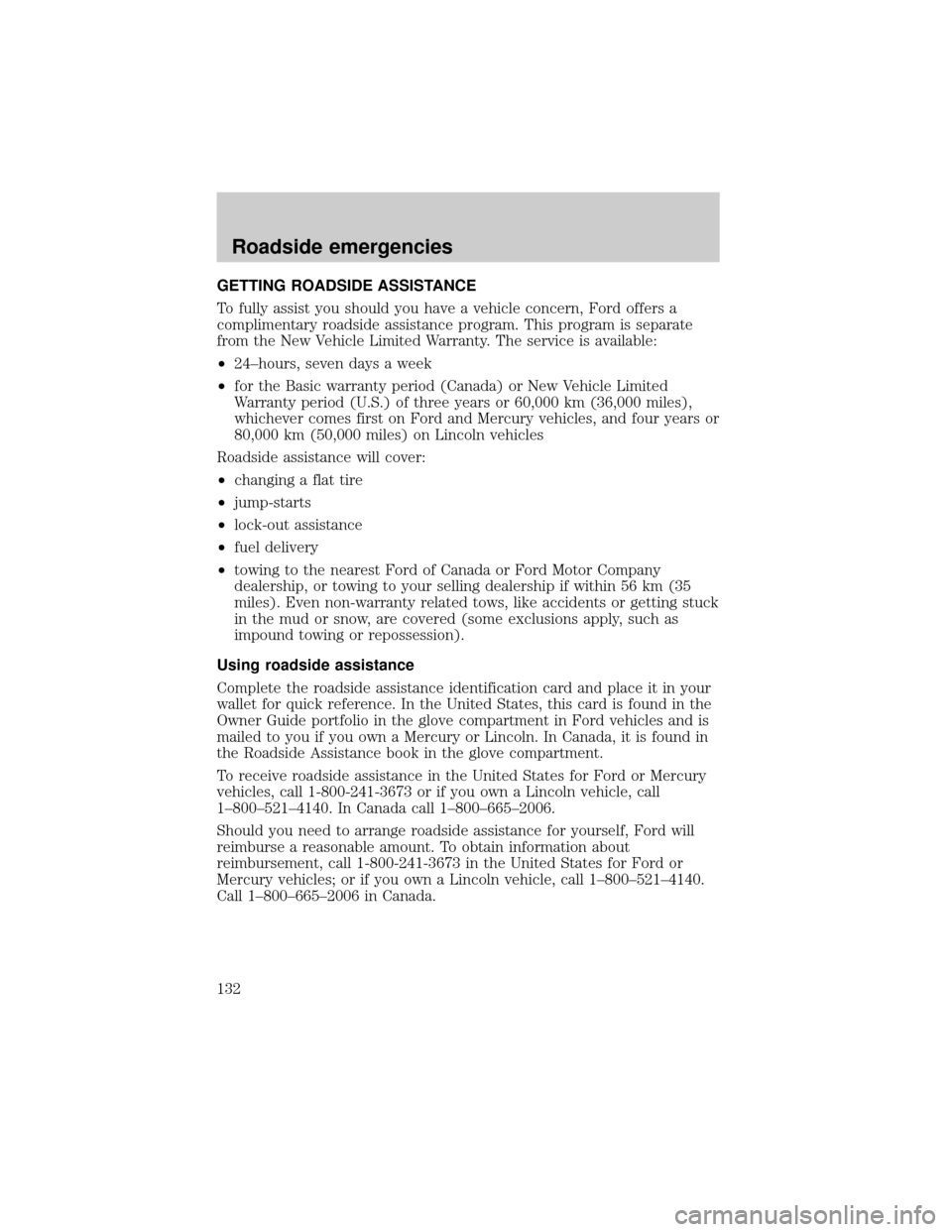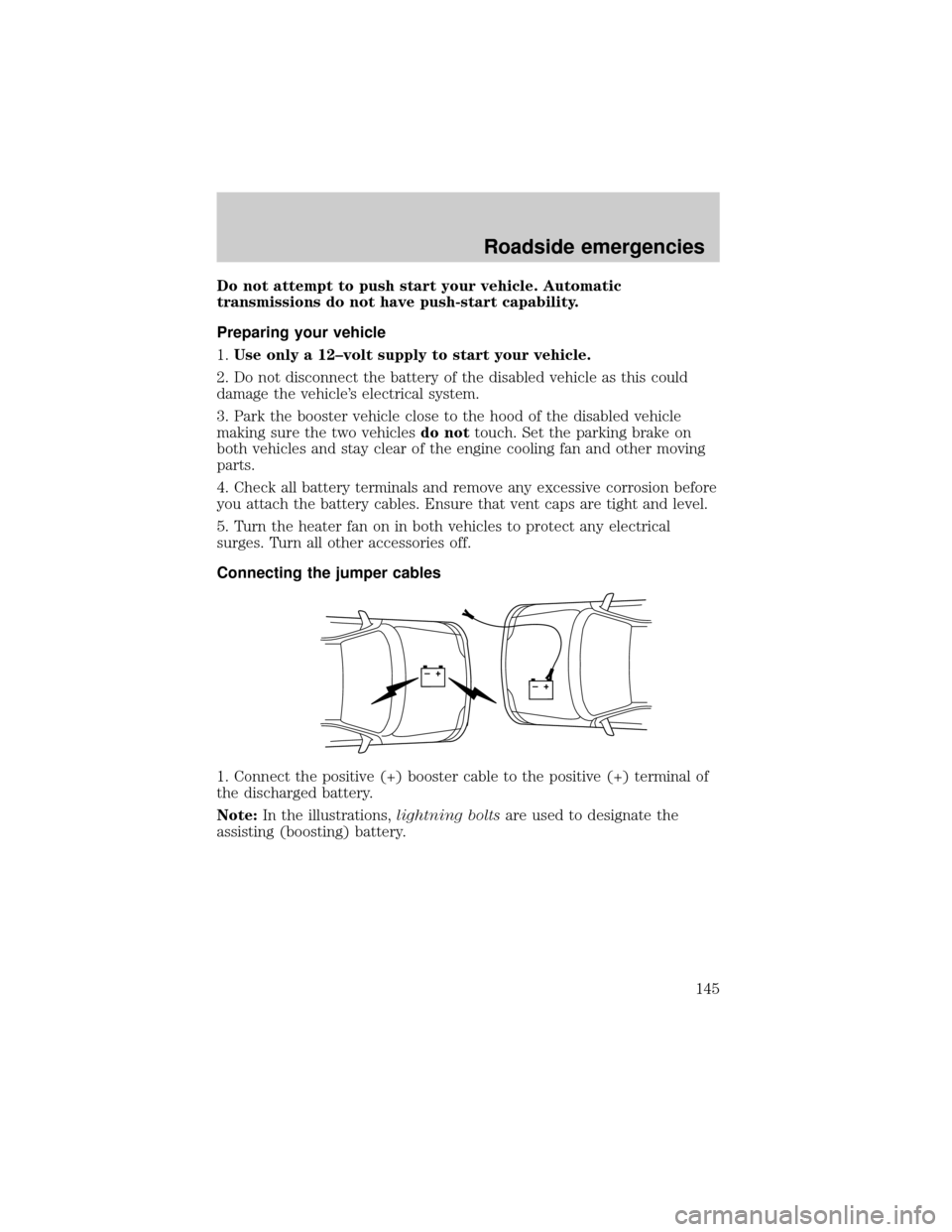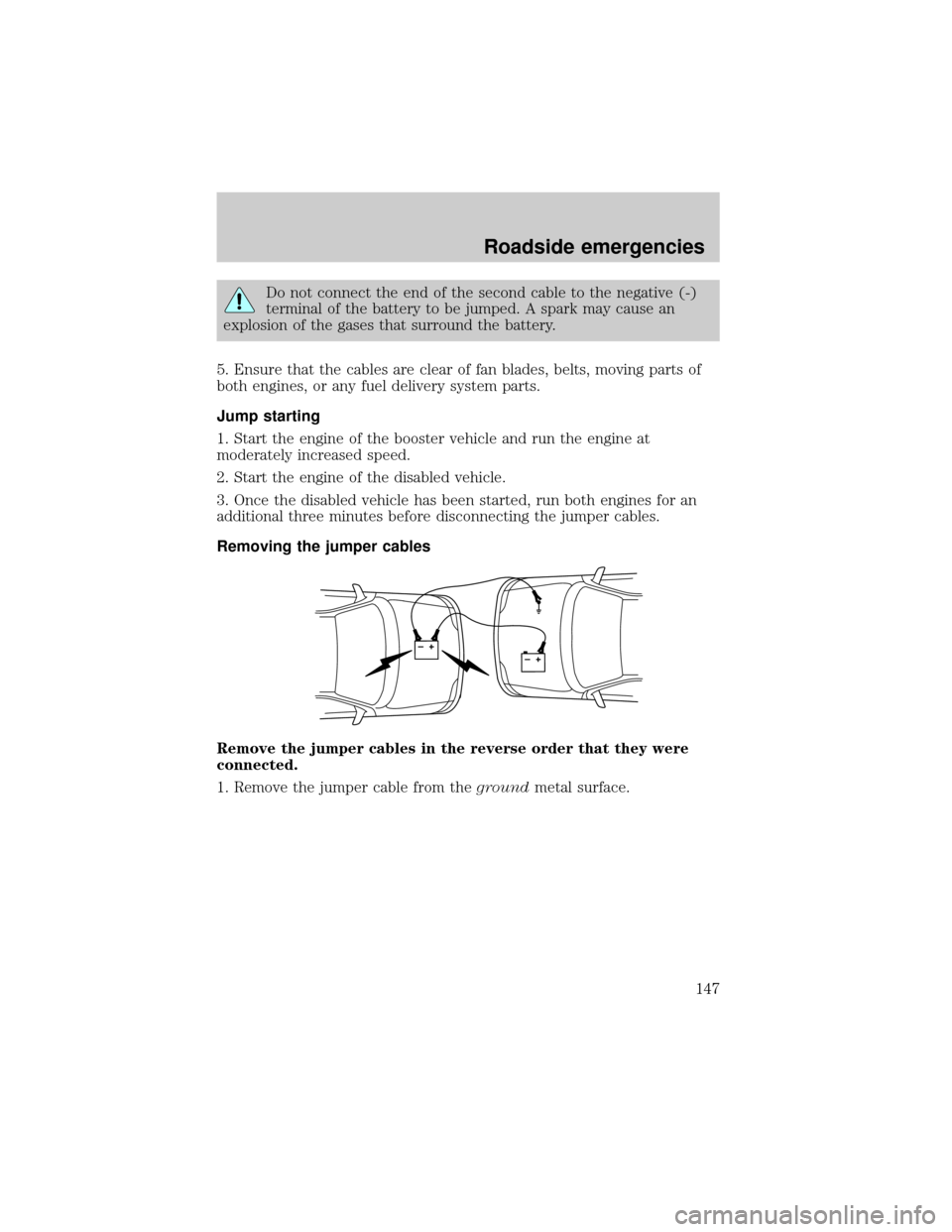2000 LINCOLN TOWN CAR jump start
[x] Cancel search: jump startPage 132 of 224

GETTING ROADSIDE ASSISTANCE
To fully assist you should you have a vehicle concern, Ford offers a
complimentary roadside assistance program. This program is separate
from the New Vehicle Limited Warranty. The service is available:
²24±hours, seven days a week
²for the Basic warranty period (Canada) or New Vehicle Limited
Warranty period (U.S.) of three years or 60,000 km (36,000 miles),
whichever comes first on Ford and Mercury vehicles, and four years or
80,000 km (50,000 miles) on Lincoln vehicles
Roadside assistance will cover:
²changing a flat tire
²jump-starts
²lock-out assistance
²fuel delivery
²towing to the nearest Ford of Canada or Ford Motor Company
dealership, or towing to your selling dealership if within 56 km (35
miles). Even non-warranty related tows, like accidents or getting stuck
in the mud or snow, are covered (some exclusions apply, such as
impound towing or repossession).
Using roadside assistance
Complete the roadside assistance identification card and place it in your
wallet for quick reference. In the United States, this card is found in the
Owner Guide portfolio in the glove compartment in Ford vehicles and is
mailed to you if you own a Mercury or Lincoln. In Canada, it is found in
the Roadside Assistance book in the glove compartment.
To receive roadside assistance in the United States for Ford or Mercury
vehicles, call 1-800-241-3673 or if you own a Lincoln vehicle, call
1±800±521±4140. In Canada call 1±800±665±2006.
Should you need to arrange roadside assistance for yourself, Ford will
reimburse a reasonable amount. To obtain information about
reimbursement, call 1-800-241-3673 in the United States for Ford or
Mercury vehicles; or if you own a Lincoln vehicle, call 1±800±521±4140.
Call 1±800±665±2006 in Canada.
Roadside emergencies
132
Page 144 of 224

Anti-theft lug nuts (if equipped)
If your vehicle is equipped with this feature, one of the lug nuts on each
wheel must be removed and replaced with a special key. The key and
registration card are attached to the lug wrench and stored with the
spare tire. If you lose the key, send the registration card to the
manufacturer (not the dealer) to get a replacement key. If the lug
wrench/lug nut key assembly is lost, see your nearest Ford or
Lincoln/Mercury dealer who has access to the master set of keys.Do not
use an impact wrench with the anti-theft key.
To remove the anti-theft lug nut:
1. Insert the key over the locking
lug nut. Make sure you hold the key
square to the lug nut. If you hold
the key at an angle, you could
damage the key and the lug nut.
2. Place the lug nut wrench over the lug nut key and apply pressure on
the key with the wrench.
3. Turn the wrench in a counterclockwise direction to remove the lug
nut.
To install the anti-theft lug nut:
1. Insert the key over the locking lug nut.
2. Place the lug nut wrench over the lug nut key and apply pressure on
the key with the wrench.
3. Install the lug nut.
JUMP STARTING YOUR VEHICLE
The gases around the battery can explode if exposed to flames,
sparks, or lit cigarettes. An explosion could result in injury or
vehicle damage.
Do not push start your vehicle. You could damage the catalytic
converter.
Batteries contain sulfuric acid which can burn skin, eyes, and
clothing, if contacted.
Roadside emergencies
144
Page 145 of 224

Do not attempt to push start your vehicle. Automatic
transmissions do not have push-start capability.
Preparing your vehicle
1.Use only a 12±volt supply to start your vehicle.
2. Do not disconnect the battery of the disabled vehicle as this could
damage the vehicle's electrical system.
3. Park the booster vehicle close to the hood of the disabled vehicle
making sure the two vehiclesdo nottouch. Set the parking brake on
both vehicles and stay clear of the engine cooling fan and other moving
parts.
4. Check all battery terminals and remove any excessive corrosion before
you attach the battery cables. Ensure that vent caps are tight and level.
5. Turn the heater fan on in both vehicles to protect any electrical
surges. Turn all other accessories off.
Connecting the jumper cables
1. Connect the positive (+) booster cable to the positive (+) terminal of
the discharged battery.
Note:In the illustrations,lightning boltsare used to designate the
assisting (boosting) battery.
+–+–
Roadside emergencies
145
Page 147 of 224

Do not connect the end of the second cable to the negative (-)
terminal of the battery to be jumped. A spark may cause an
explosion of the gases that surround the battery.
5. Ensure that the cables are clear of fan blades, belts, moving parts of
both engines, or any fuel delivery system parts.
Jump starting
1. Start the engine of the booster vehicle and run the engine at
moderately increased speed.
2. Start the engine of the disabled vehicle.
3. Once the disabled vehicle has been started, run both engines for an
additional three minutes before disconnecting the jumper cables.
Removing the jumper cables
Remove the jumper cables in the reverse order that they were
connected.
1. Remove the jumper cable from thegroundmetal surface.
+–+–
Roadside emergencies
147
Page 149 of 224

After the disabled vehicle has been started and the jumper cables
removed, allow it to idle for several minutes so the engine computer can
relearnits idle conditions.
WRECKER TOWING
If you need to have your vehicle towed, contact a professional towing
service or, if you are a member, your roadside assistance center.
It is recommended that your vehicle be towed with a wheel lift or flatbed
equipment. Do not tow with a slingbelt. Ford Motor Company has not
approved a slingbelt towing procedure.
Before your vehicle can be towed, the air suspension control in the
luggage compartment must be turned to the OFF position (if equipped).
If the vehicle is towed by other means or incorrectly, vehicle
damage may occur.
Ford Motor Company provides a towing manual for all authorized tow
truck operators. Have your tow truck operator refer to this manual for
proper hook-up and towing procedures for your vehicle.
Roadside emergencies
149
Page 215 of 224

Compass, electronic
calibration .................................19
set zone adjustment ............18,19
Console
rear ............................................70
Controls
power seat ............................84,86
steering column ........................60
Coolant
checking and adding ..............157
coolant temperature light ........11
refill capacities .................160,195
specifications ...................197,198
Cruise control
(see Speed control) ....................56
Customer Assistance ................132
Ford accessories
for your vehicle ......................209
Ford Extended
Service Plan ............................202
Getting assistance outside
the U.S. and Canada ..............208
Getting roadside assistance ...132
Getting the
service you need ....................203
Ordering additional
owner's literature ...................212
The Dispute
Settlement Board ...................205
Utilizing the Mediation/
Arbitration Program ...............208
Daytime running lamps
(see Lamps) ................................23
Defrost
rear window ..............................53
Dipstick
automatic
transmission fluid ...................164
engine oil .................................153
Doors
door ajar warning .....................12
lubricant specifications ..........197Driving under special
conditions
through water .........................131
Emergencies, roadside
jump-starting ..........................144
Emission control system ..........182
Engine ........................................198
check engine/service engine
soon light ....................................8
cleaning ...................................193
coolant .....................................157
fail-safe coolant ......................161
idle speed control ...................166
lubrication
specifications ...................197,198
refill capacities ........................195
service points ..........................152
starting after a collision .........133
Engine block heater .................116
Engine oil ..................................153
change oil soon warning,
message center .......................153
checking and adding ..............153
dipstick ....................................153
filter, specifications .........155,195
recommendations ...................155
refill capacities ........................195
specifications ...................197,198
Exhaust fumes ..........................117
Fail safe cooling ........................161
Floor mats ...................................71
Fluid capacities .........................195
Fuel ............................................174
calculating fuel economy ..20,179
cap ...........................................176
capacity ...................................195
choosing the right fuel ...........177
comparisons with EPA fuel
economy estimates .................182
detergent in fuel .....................178
filling your
vehicle with fuel .......174,176,179
Index
215
Page 216 of 224

filter, specifications .........178,195
fuel filler door override ............67
fuel filler door release ..............66
fuel pump shut-off switch .....133
gauge .........................................15
improving fuel economy ........179
octane rating ....................177,198
quality ......................................177
running out of fuel .................178
safety information relating
to automotive fuels ................174
Fuses ...................................134,135
Garage door opener ....................61
Gas cap (see Fuel cap) ............176
Gas mileage
(see Fuel economy) .................179
Gauges .........................................15
engine coolant
temperature gauge ...................16
fuel gauge ..................................15
odometer ...................................15
speedometer .............................16
GAWR
(Gross Axle Weight Rating) .....127
definition .................................127
driving with a heavy load ......127
location ....................................127
GVWR (Gross Vehicle
Weight Rating) ..........................127
calculating ...............................127
definition .................................127
driving with a heavy load ......127
location ....................................127
Hazard flashers .........................133
Head restraints ...........................84
Headlamps ...................................23
aiming ........................188,189,190
autolamp system .......................23
bulb specifications ..................188
daytime running lights .............23
flash to pass ..............................24
high beam ............................10,24replacing bulbs .......................184
turning on and off ....................23
warning chime ..........................14
Heating ........................................24
HomeLink universal
transceiver (see
Garage door opener) ...61,62,63,64
Hood ..........................................151
Ignition .......................................198
positions of the ignition ...........54
Infant seats
(see Safety seats) .....................107
Inspection/maintenance
(I/M) testing ..............................183
Instrument panel
cleaning ...................................193
cluster ..........................................8
lighting up
panel and interior .....................23
location of components ..............8
Jump-starting your vehicle ......144
Keyless entry system .................77
autolock .....................................75
keypad .......................................77
programming entry code .........78
Keys .............................................55
key in ignition chime ...............14
positions of the ignition ...........54
Lamps
autolamp system .......................23
bulb replacement
specifications chart ................188
cargo lamps ...............................23
daytime running light ...............23
headlamps .................................23
headlamps, flash to pass ..........24
instrument panel, dimming .....23
interior lamps ....................65,188
replacing bulbs .........184,186,187
Lane change indicator
(see Turn signal) ........................55
Lights, warning and indicator ......8
Index
216
Page 218 of 224

memory seat ...................69,76,88
SecuriLock passive anti-theft
system ................................80,81,82
Servicing your vehicle ..............150
Spark plugs,
specifications ......................195,198
Specification chart,
lubricants ............................197,198
Speed control ..............................56
Speedometer ...............................16
Starting your vehicle .........114,116
jump starting ..........................144
Steering
speed sensitive .......................122
Steering wheel
controls ......................................60
tilting .........................................55
Tilt steering wheel ......................55
Tires ......................140,170,171,172
changing ...........................140,141
checking the pressure ............172
replacing ..................................173
rotating ....................................172
snow tires and chains ............173
tire grades ...............................171
treadwear ................................171
Towing ................................128,172
trailer towing ..........................128
wrecker ....................................149
Traction control ........................120active light ................................13
how to enable/disable ............121
off light ......................................12
Traction-lok rear axle ...............126
Transmission .............................123
fluid, checking and adding
(automatic) .............................164
fluid, refill capacities ..............195
lubricant specifications ...197,198
Trunk ...........................................83
remote release .....................66,73
Turn signal ........................10,14,55
Vehicle dimensions ...................198
Vehicle Identification
Number (VIN) ...........................201
Vehicle loading ..........................127
Ventilating your vehicle ...........117
Warning chimes ...........................14
Warning lights (see Lights) .........8
Washer fluid ..............................157
Water, Driving through .............131
Windows
power .........................................67
Windshield washer
fluid and wipers
checking and adding fluid .....157
checking and cleaning ............169
operation ...................................56
replacing wiper blades ...........169
Wrecker towing .........................149
Index
218